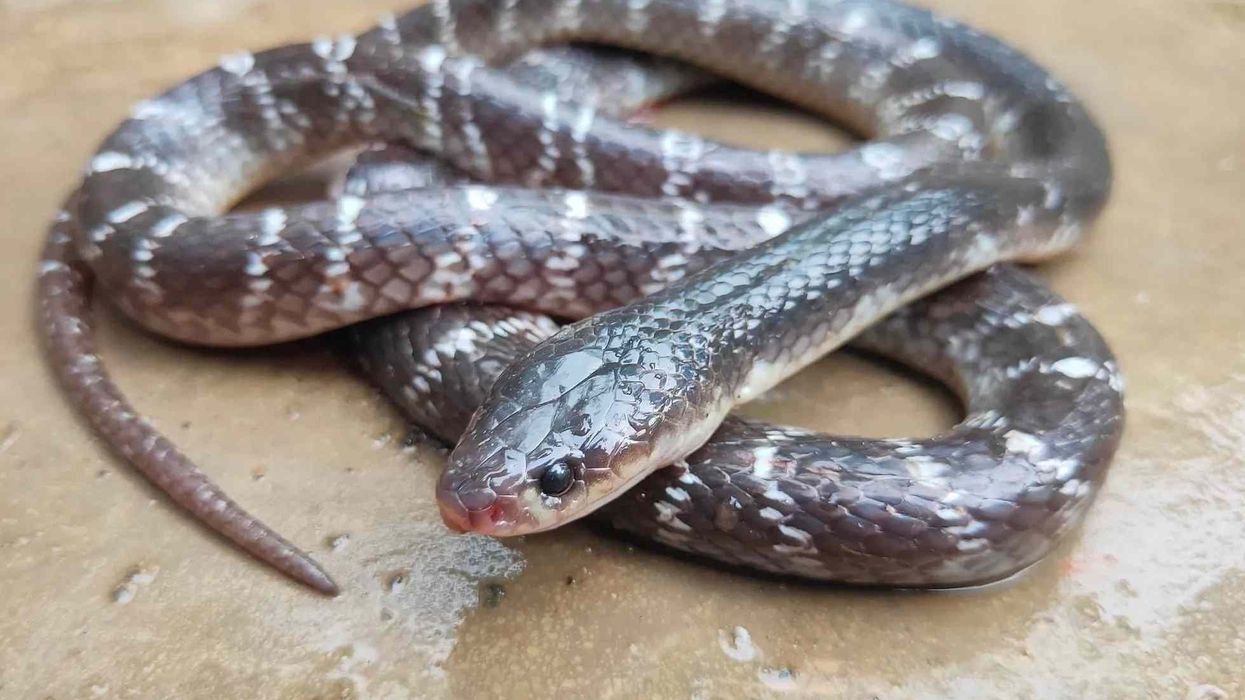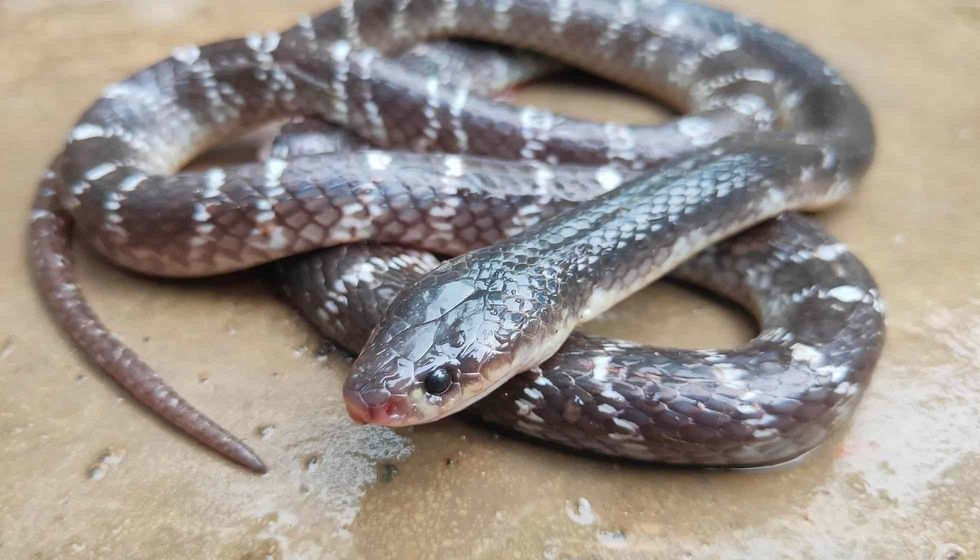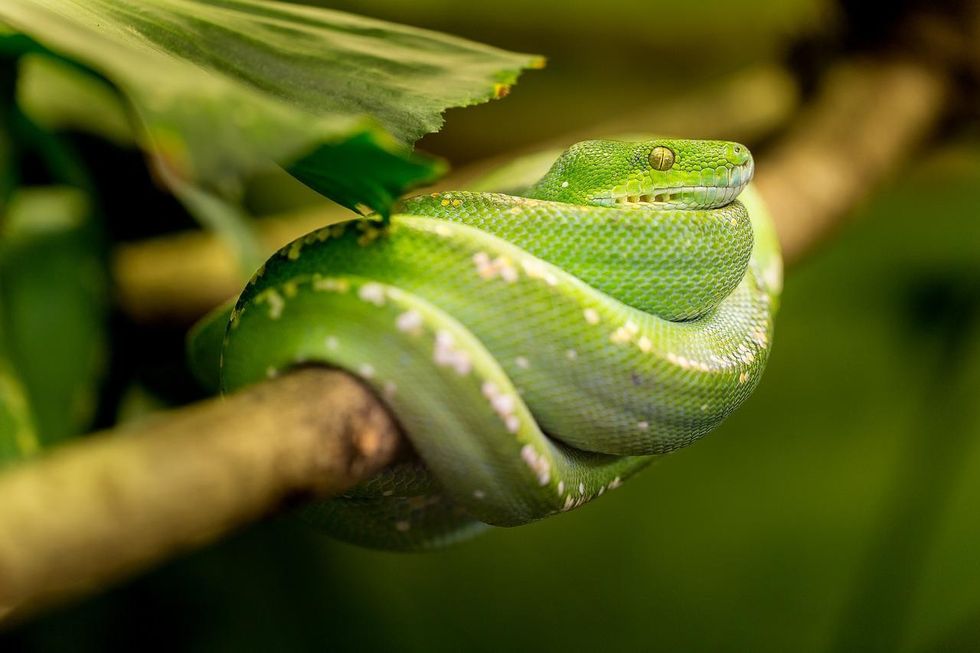The common or krait (Indian blue krait), also recognized as Indian krait and blue krait (Bungarus caeruleus), belongs to the venomous group of the genus Bungarus found generally in the forests of the Indian subcontinent. It is a member of the significant four kinds, causing the most snakebites on humans in India.
The habitat range is wide comprising the continent of Asia and South Asia and highly active at night.
Dangerous is the most common name used to describe the krait bite. A clinical study provides an untreated Indian krait mortality rate of 70-80%.
This snake has the prominence of being the deadliest snake in India because of postsynaptic neurotoxins present in the venom, within its geographical distribution, and all snakes that look similar to it also suffer because of this.
If you loved reading this, then you can discover more about other Anaconda snake or Scarlet snake facts.
Indian Krait Interesting Facts
What type of animal is an Indian krait?
It is an animal belonging to the snake family. The word krait is obtained from the Hindi word for the species karait. It is commonly known as kraits in Madhya Pradesh and some parts of Uttar Pradesh in India, though the origins of the word are unknown.
What class of animal does an Indian krait belong to?
They belong to the reptile class known to be nocturnal in nature. The krait (B. caeruleus) is very active and aggressive at night and known to be reluctant to bites. But, when agitated then it injects a considerable amount of venom. The patient may become numb and suffer paralysis as the venom is deadly.
How many Indian kraits are there in the world?
According to the research, around 12 species of kraits found so far that belong to the cobra family.
Where does an Indian krait live?
The common krait (blue krait) distribution is seen in Peninsular India from Pakistan to the West Bengal plains. It is also found throughout South India and Sri Lanka at elevations up to 5249ft (1600 m).
It is also reported in Nepal, Afghanistan, and Bangladesh. The common krait species is usually discovered in water or in the vicinity of a water source. The common krait occupies rainforest, scrub forest, dry, moist, or mixed deciduous forest, semi-deserts with alluvial soil, wetlands, grasslands, agricultural lands, and rocky terrain.
What is an Indian krait's habitat?
The common krait's, Bungarus caeruleus, scope encompasses a wide variety of habitats. It is found in grasslands and low scrub jungle, as well as populated areas.
It is known to take up residence in termite piles, brick piles, rat holes, and even inside the houses. This is the only reason why this member of the big four is accountable for more human deaths in India.
Who do Indian kraits live with?
They are solitary animals only coming together for mating and hibernation. Their aggressive behavior and strong venom restrict them to form groups.
How long does an Indian krait live?
They can live around 10-17 years.
How do they reproduce?
They are oviparous snakes; the male's combat during the spring and summer seasons. Females lay up to 12-14 eggs in mounds, holes, and in leaf litters. They even supervise their clutches until the young hatch.
Young ones arrive in April. These not very thick hatchlings are brightly printed. They have a neckband around their necks that fades, along with many bands near the head as they grow older.
What is their conservation status?
There are no identified threats to common kraits at present. They are not included in the IUCN Red List, and their conservation status has not been assessed.
Indian Krait Fun Facts
What do Indian kraits look like?
The head of the common krait is flat, and the neck is hardly visible. The body is barrel-shaped, narrowing towards the end, and the tail is short and rounded. Apart from that, their eyes are small, with round pupils.
The head shields are regular. In addition to that, the scales of these snakes are gleaming, and the vertebral row is expanded and hexagonal. Their tongue is pinkish or reddish in color.
Their coloration of the species is generally black or bluish-black, with about 40 thin, white crossbars. The pattern, however, is complete and well defined in the small ones, which are marked with distinct crossbars.
In older common krait, there are narrow white lines that may be found as a series of connected spots, with a noticeable spot on the vertebral region, and the upper lips and belly are white.

How cute are they?
Only snake lovers and herpetologists can find the Indian krait snake, (Bungarus caeruleus) cute and amazing species. Others find them extremely dangerous as many victims ended up in hospitals after the fatal bites.
How do they communicate?
Common krait snakes hiss loudly when disturbed. They coil their body with the head hidden and body flattened, lift their tail and make jerky movements. The most hidden spots are rat holes beneath the debris or brick piles and termite mounds and under the loose soil. At night, they even remain still to avoid bites.
How big is an Indian krait?
The normal length of the common krait, Bungarus caeruleus, is 3.0 ft (0.9 m ), but they can grow to 5 ft 9 in (1.75 m). Males are longer than females with proportionately longer tails.
How fast can an Indian krait move?
The Indian common krait snake can move fast depending upon the situation.
How much does an Indian krait weigh?
They are not that heavy as compared to Eastern diamondback rattlesnake who is known to be the heaviest among all.
What are the male and female names of the species?
The common Indian krait snake doesn't have a designated name for male and female.
What would you call a baby Indian krait?
The baby krait is referred to as a snakelet or hatchling snake. The common belief that circulates is that they eat a large number of insects, worm snakes, and hatchling lizards.
What do they eat?
The common krait, unlike some of its cousins, such as the banded krait (Bungarus fasciatus) that feeds almost exclusively on snakes, the Indian krait diets have a broader prey base. It feeds on other snakes that include blind worms (snakes of the genus Typhlops) and other kraits as well, including the young.
It (B. caeruleus) is also seen feeding on small mammals such as rats and mice, lizards, and frogs. The juvenile feeds on arthropods.
Are they poisonous?
The common krait's venom comes under big four venomous snakes and can be harmful to humans. There is evidence that the bite of this snake can be fatal and 10 times highly venomous than cobra.
In Bangladesh, more than 50% of the total snakebite deaths are caused due to krait venom. The presence of potent no cytotoxic affects the blood cells, tissue, blood, and other components of the body and the neurotoxin present in the venom blocks signals from the nerve endings from being sent to the receptors of the muscles.
Also, the powerful neurotoxins induce muscle paralysis. Once bitten, the victim has complained of severe abdominal cramps followed by progressive paralysis and respiratory failure.
They have tiny fangs, and the bite causes little to no pain initially. Hence, victims are clueless about the bite and don't take it seriously.
In Maharashtra rural areas, people usually sleep on the floor using sheets and blankets. It is believed that kraits are attracted to the smell of sheets and blankets that reek of rodent odor. Hence, kraits might mistake the movement in the dark and intensifies the bite, thus injecting considerable amounts of venom as a feeding response.
Would they make a good pet?
Krait venom species are highly venomous and one bite causes death. So, there is no point in having them as a pet.
Did you know...
The common krait bite has been recognized as having the most potent venom of any snake in India and is also the deadliest one along with Russell's viper and King cobra.
If a human is bitten by a krait, then the absorption of the venom into the victim can be delayed by applying a pressure bandage to the bite site n order to immobilize the area. This will prevent the venom from spreading, and buy some till they reach the hospital.
Snakes can be venomous or not, but kraits are venomous. Also, the head of the snakes are wide, and that of kraits are slender. The former can be active in the day and night, while the latter is only active in the night. Apart from that, the scales of the kraits are glossy as compared to the snakes.
How do you identify an Indian krait?
The common krait (Bungarus caeruleus) species is always confused with the wolf snake. But, their venom is severe, and the wolf snake is non-venomous. They both are nocturnal, mostly active at night.
Kraits can be identified by a body that is triangular in cross-section, with clearly large scales along the spine. The stripes are more prominent, while in the wolf snake, they are consistent throughout the body. Also, the background color is jet-black or bluish-black, whereas the wolf snake tends to be brownish, although there can be significant variation.
Are Indian kraits endangered?
No, they are not endangered species as they do not come under the list. Their conservation status is also not evaluated at present.
Here at Kidadl, we have carefully created lots of interesting family-friendly animal facts for everyone to discover! For more relatable content, check out these rubber boa facts and vine snake facts pages.
You can even occupy yourself at home by coloring in one of our free printable Krait coloring pages.










